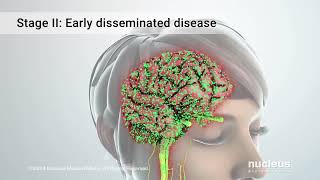![]()
MEDICAL ANIMATION TRANSCRIPT: Lyme disease, also called Borreliosis, is an infection caused by a tiny bacterium called Borrelia burgdorferi. Animals related to spiders called black-legged ticks, also known as deer ticks, can become infected with this bacterium. You can catch Lyme disease if you are bitten by an infected tick. Ticks have four life stages, an egg, a six-legged larva, an eight-legged nymph, and an adult. To survive and grow, a tick must eat the blood of a host animal at every stage of development. If the host animal is already infected with the bacteria, the tick can become infected when it feeds on the host animal’s blood. Then you may pick up the infected tick, either from a grassy, brushy, or wooded area, or from an animal that has an infected tick on it. If an infected tick attaches to you, it can transfer the bacteria into your body. As the bacteria invade and multiply in your skin, they do not make toxins or chemicals that directly damage your tissue. Instead, they make chemicals that attract your immune cells, which try to clear the infection. This immune response can inflame and damage your skin cells. From there, Lyme disease has three stages that can overlap. Early localized disease, early disseminated disease, and late disease. During the early localized stage, you may have a red rash, called erythema migrans. It usually appears around the tick bite 7 to 14 days after you are bitten. During the early disseminated stage, the bacteria begin to enter your bloodstream. This happens days to weeks after the bite. The bacteria can spread throughout your bloodstream to inflame the tissue of your organs, including your brain, nerves, and heart. If not treated, the disease can progress to the late stage. During this stage, the infection can spread throughout your body. This happens months or years after the bite. Muscle and joint symptoms are common in this stage. The main risk for getting Lyme disease is spending a lot of time outside, in places where infected ticks live. Having a pet that may carry infected ticks home from these areas can also increase your risk. A common symptom of early Lyme disease is the erythema migrans rash. While it may have a bullseye shape, it often doesn’t. Other symptoms may include fever, chills, headache, feeling tired, achy muscles and joints, and swollen lymph nodes. If not treated, it may spread to other parts of your body and cause the following symptoms. A stiff neck, severe headaches, facial palsy, which is drooping or loss of muscle tone on one or both sides of your face, an abnormal or fast heartbeat, feeling dizzy, shortness of breath, nerve pain, pain, numbness or tingling in the hands or feet, and problems with memory or concentration. If you have Lyme disease, your healthcare practitioner may prescribe oral antibiotics. For severe symptoms, you may need an injection of antibiotics through an IV or in a muscle. It’s important to be treated as early as possible for the best chance of recovery. One way to prevent Lyme disease is to avoid the places where ticks live. If you do go into these areas, use an insect repellent that contains chemicals such DEET or Picaridin, wear long pants and a long-sleeved shirt. Treat your clothes and gear with a chemical that kills insects called permethrin. And walk in the center of trail paths to avoid grassy or brushy areas. After returning from these areas, inspect your clothes, gear, and pets for ticks. Put your clothes in a dryer on high heat for at least 10 minutes to kill any ticks on them. Use a mirror or have someone help you check for ticks on your body. Under your arms, in and around your ears, in and around your hair, around your waist, in your belly button, and between your legs. And take a shower within two hours after returning from outdoors. To find out more about Lyme disease, talk to your healthcare practitioner.
#LymeDisease #borreliosis #DeerTickBite
ANH24278
